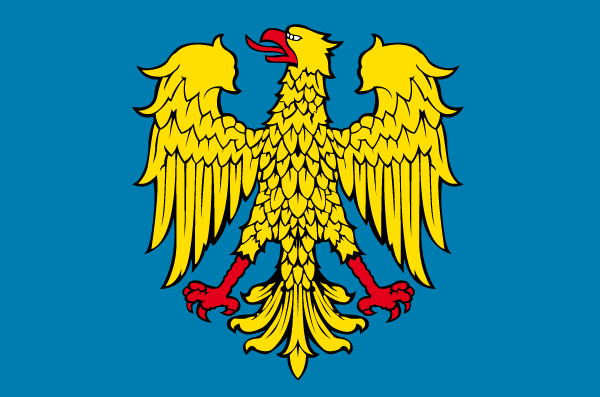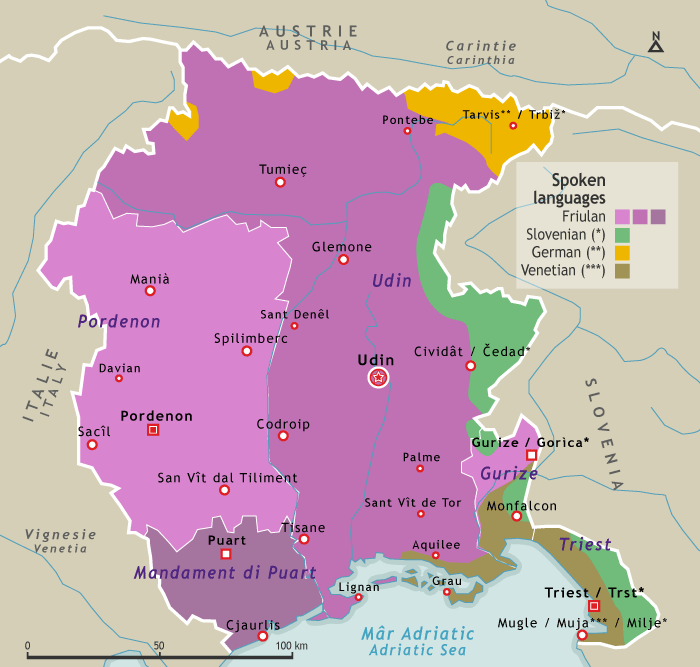Friuli, border of empires

Friuli is numerically the most important Rhaeto-Romance nation. In fact, Friulians, along with the Romansh and Ladins, make up three historic nations of Romance culture in central Europe.

Like a large number of minority peoples, the Friulians are distinguished by their language. It is also due to their rich history that Friulians are eligible for special status in an Italy anxious to develop regional autonomy.
Initially populated by the Celts and the Carni, Friuli was colonised by the Romans before becoming a buffer zone between the Barbarians and the Roman Empire. It is during the Middle Ages, in the 8th century, that Friuli acquired legal status for the first time. It was a duchy during the reign of King Alboin of Lombardy. From the 12th century, and for six further centuries, Friuli had a parliament representing the municipalities, the nobility and the clergy. From the 11th to the 14th century, under the administration of the diocese of Aquileia, Friuli saw a period of exceptional democratisation, particularly with the creation of the parliament. During the rule of Lombardy and that of the Franks, the Friulians experienced a difficult period when they were governed by the Venetians, who depleted their lands. They lost their institutions under the oppression of Napoleon Bonaparte, who put an end to the legislative privileges of the duchy in 1805. From the congress of Vienna in 1815 and during the First World War, Friuli was shared between Austria and Italy.
From 1918, demands for autonomy became more pressing, but Italian fascism did not allow any progress. After the Second World War, through the efforts of the Autonomist Association of Friuli, a region called Friuli-Venetia-Giulia was created, however, this did not meet the hopes of the autonomists. Populated by 90% of Friulians, different languages are spoken there, mainly Friulian, but also Ladin, German and Slovenian.

Identity card

| Name | Friûl | Frioulan Friuli | Italian Friaul | German Furlanija | Slovenian (Friuli) |
| Population | 1,060,000 inhab. (2007) |
| Area | 8,538 km² |
| Languages | Furlan | Frioulan Italiano | Italian (officielles) Deutsch | German Slovenščina | Slovenian Ladin | Ladin (without official status) |
| Number of native speakers | 600,000 | Frioulan |
| State of guardianship | Autonomous region in Italy |
| Official status | Italy |
| Capital | Udin | Friulian Udine | Italian (Udine) |
| Historic religion | Roman Catholic |
| Flag | Bandiere dal Friûl | Friulian (Flag of Friuli) |
| Anthem | None |
| Motto | None |

Timeline

- 2nd century BC • Settling of the Romans followed by the Celts.
- 31–14 BC • Apogee of Aquileia, second capital of the Roman Empire and Friuli.
- 7th century AD • The Lombards create the duchy of Friuli.
- 1077–1420 • The bishop of Aquileia controls Friuli and creates a parliament.
- 1420 • Annexing of Friuli by the Republic of Venice.
- 1516 • The Austrians take control of east Friuli.
- 1805 • Napoleon Bonaparte sells the whole of Friuli to the Austrians and puts an end to the duchy.
- 1815–66 • Friuli is part of the kingdom of Lombardy-Venetia.
- 1922–45 • Under the fascist Italian regime, the Friulians are victims of a campaign of forced assimilation.
- 1960 • First pro-autonomist movement.
- 1963 • Creation of the autonomous region of Friuli- Venetia-Giulia.

Brief history

‘Joibe grasse’ (Fat Thursday) of 1511, is the name of a popular revolt started in Udine by the citizens dying of hunger, helped by farmers throughout Friuli. These insurgencies, violently repressed by the Venetian authorities forever marked the history of Friuli and its relations with its dominant Venetian neighbour. Between 1550 and 1600 the population of Friuli decreased from 200,000 to less than 100,000 inhabitants. This is one of the events marking the long drawn-out history between neighbours eager for power but not inclined to share wealth.

Geography

Friuli is often confused with the
Friuli-Venetia-Giulia region. Historically Friuli belongs more or less to the
Italian region separated by its mid-point, namely Mandamento di Portogruaro (or
Mandament di Puart in Friulian) and the community of Sappada, now incorporated
into Venetia. Friuli is a buffer region, i.e. it links different states – Italy
to the east, Austria to the north (Carinthian Alps) and Slovenia to the east
(Giulian Alps). To the south, the Adriatic Sea provides access to the
Mediterranean. Udin (in Friulian) (Udine in Italian) is the capital. It is
situated in the middle of the country, consisting of plains and hills to the
centre and south and massive alpine mountains to the north of which Monte
Coglians (2,780 m) is the highest. Friuli traditionally has five
provinces: Udin, Pordenon, Gurize, Triest and Mandament di Puart (shown on the
map). The most spoken minority language is Friulian, although German is spoken
in the north, Slovenian to the east and Venetian to the south-east.



